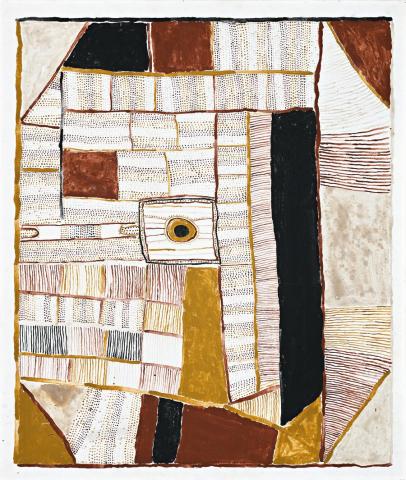UNTITLED, 1998
KUTUWULUMI PURAWARRUMPATU (KITTY KANTILLA)
natural earth pigments and synthetic binder on canvas
92.0 x 79.0 cm
inscribed verso: artist’s name and Jilamara Arts and Crafts cat. 980266
Jilamara Arts and Crafts, Melville Island (stamped verso)
Aboriginal and Pacific Art, Sydney
Private collection, Sydney
Sotheby’s, Melbourne, 24 June 2002, lot 30
Private collection, New South Wales
Kitty Kantilla Kutuwalumi Purawarrumpatu, Aboriginal and Pacific Art, Sydney, 1 - 24 October 1998
Kitty Kantilla, National Gallery of Victoria, Melbourne, 27 April - 19 August 2007;
Art Gallery of New South Wales, Sydney, 7 December 2007 - 21 January 2008, cat. 60 (label attached verso)
Ryan, J., Kitty Kantilla, National Gallery of Victoria, Melbourne, 2007, p. 53 (illus.)
Kitty Kantilla’s Untitled, 1998, is significant for being one of the earlier works to represent a fundamental shift away from her characteristic black ground by the introduction of a white ground. Kantilla’s black ground works were a more literal translation of the Tiwi body paint decoration for which she had become so well known. It was this dramatic transition to white canvas that catapulted her work into the realm of deep abstraction, as though a light had been turned on all the cultural ceremonial elements Kantilla had been taught to paint by her father. As Judith Ryan astutely observed, ‘The white surface broke the direct link between surface of object or body and two-dimensional painting and introduced stronger tonal contrasts, giving life to dramatic divisions of space, larger fields of colour and the adventurous use of squares and lines within rectangles on a white wall.’1
Regarded as the ‘queen of Jilamara’, Kitty Kantilla possessed a lightness of touch, evoking the ethereal elements of the customary ritual and ceremony at the heart of her paintings. The sense of sacred music and dance pervades her work and this appears all the more evident in her white ground paintings. The deftly applied line work and dotting, known as mulypinyini pwanga, represent the body paint designs associated with Tiwi ceremony, the larger rectangular pools of ochre and pigment show the tutini or grave poles, which are the central object of the Pukumani ceremony. Untitled was shown to great acclaim at her largest solo show ever at Aboriginal and Pacific Art in Sydney in 1998 and was a prominent inclusion in the National Gallery of Victoria retrospective in 2007. Culminating in the central roundel it is a loose arrangement of blocks of solid ochres, striated lines and Kitty’s leitmotif of delicately dotted spaces, all of which seem to float on the white canvas. It is both ancient and modern in the one instance.
1. Ryan, J., ‘“Dot Dot” - the Art of Kitty Kantilla’, in Meridian: Focus on Contemporary Australian Art, Museum of Contemporary Art, Sydney, 2002, p. 99
LARA NICHOLLS
